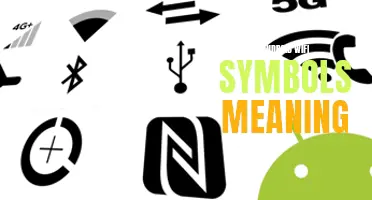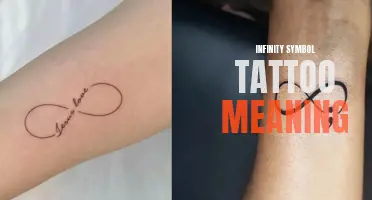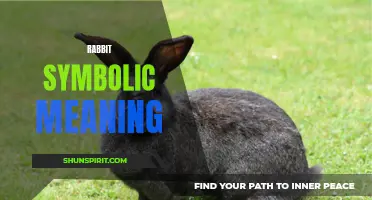
In every culture and throughout history, symbolism has played a significant role in witchcraft practices. From the shape of a pentagram to the use of herbs, each symbol holds a profound meaning and power within the world of witchcraft. These symbols not only serve as a tool for communication and expression within the witchcraft community, but they also invite individuals to explore the depths of their own spirituality and connect with the mystical forces of the universe. So, join me on a journey as we unravel the intricate and fascinating world of witchcraft symbol meanings.
What You'll Learn
- What are the most commonly recognized symbols used in witchcraft and what do they represent?
- How does the use of symbols in witchcraft differ between different traditions or belief systems?
- Are there any specific symbols used in witchcraft that have multiple meanings depending on their context?
- How have the meanings of certain witchcraft symbols evolved or changed over time?
- How can individuals incorporate symbols into their own practice of witchcraft and use them to enhance their rituals or spellwork?

What are the most commonly recognized symbols used in witchcraft and what do they represent?
Witchcraft is a diverse practice that encompasses a wide range of beliefs and traditions. One common aspect of witchcraft is the use of symbols, which hold special meaning and power for practitioners. These symbols can be found in various forms, such as tattoos, jewelry, or even in artwork.
One of the most recognized symbols in witchcraft is the pentagram. The pentagram is a five-pointed star, enclosed within a circle. Each point of the star represents an element - earth, air, fire, water, and spirit. The pentagram is often associated with protection, balance, and the connection between the physical and the spiritual realms.
Another widely recognized symbol in witchcraft is the triquetra. The triquetra is a Celtic knot that consists of three interconnected loops or arcs. It is often used to represent the triple goddess - maiden, mother, and crone - as well as the concept of the trinity. The triquetra is commonly associated with feminine power, unity, and the cycles of life.
The moon is also an important symbol in witchcraft. The phases of the moon hold special significance and are often used for timing spells and rituals. The waxing crescent represents new beginnings and growth, while the full moon is associated with heightened energy and manifestation. The waning crescent represents release and letting go, while the dark moon symbolizes introspection and renewal.
The pentacle is another commonly recognized symbol in witchcraft. Similar to the pentagram, the pentacle is a five-pointed star, but it is surrounded by a circle. The pentacle represents the element of earth and is often used in rituals and ceremonies for grounding and protection.
The triple moon symbol is often associated with the goddess and the phases of the moon. It consists of three crescent moons, representing the waxing, full, and waning phases. The triple moon symbolizes the cyclical nature of life, death, and rebirth, as well as the divine feminine.
The ouroboros is a symbol of a serpent or dragon eating its own tail, forming a circle. It represents the eternal cycle of life and death, as well as the concept of infinity. The ouroboros is often associated with transformation, renewal, and the eternal nature of the soul.
The Hecate's wheel is a symbol associated with the goddess Hecate, who is often viewed as a protector of witches and a guide to the underworld. It consists of a circle intersected by four lines, creating eight spokes. The Hecate's wheel represents the seven planetary bodies known to the ancients, as well as the center representing the goddess herself.
These are just a few examples of the many symbols used in witchcraft. Each symbol holds its own unique meaning and power, and can be incorporated into rituals, spells, or personal practices. It is important to remember that symbolism in witchcraft can vary among individuals and traditions, so it is always best to explore and create personal connections with symbols that resonate with you.
Unlocking the Secrets: Exploring Mason Symbols and Their Deep Meanings
You may want to see also

How does the use of symbols in witchcraft differ between different traditions or belief systems?
Symbols are a powerful tool used in witchcraft to invoke energy, focus intentions, and communicate with the spirit world. However, the use of symbols in witchcraft can vary greatly between different traditions and belief systems. Each tradition has its own unique set of symbols that hold specific meanings and associations.
In Wicca, one of the most well-known traditions of witchcraft, symbols play a central role in rituals and spellwork. The Wiccan pentacle, a five-pointed star within a circle, is one of the most widely recognized symbols in witchcraft. It represents the five elements - earth, air, fire, water, and spirit - and is often worn as a necklace or used as an altar tool. Other symbols commonly used in Wicca include the triple moon, representing the phases of the moon, and the athame, a ritual dagger used for casting circles and directing energy.
In traditional witchcraft, symbols are often drawn or carved into objects or the ground. These symbols are believed to hold specific powers and can be used to invoke or banish certain energies. The use of symbols in traditional witchcraft is often more personalized and may vary between practitioners. Some common symbols used in traditional witchcraft include the pentagram, various runes, and sigils.
In other forms of witchcraft, symbols may be influenced by specific cultural or religious traditions. For example, in Hoodoo or African American folk magic, symbols such as the crossroads, mojo bags, and the color red are commonly used. In Santeria, an Afro-Caribbean religion, symbols such as the Orisha veve (sacred symbols representing deities) and certain colors and numbers are important in rituals and spellwork.
The use of symbols in witchcraft can also vary depending on the practitioner's personal beliefs and preferences. Some witches may create their own symbols based on their personal experiences or spiritual connections. These symbols may hold personal meaning and power for the individual and may not be widely recognized or used outside of their practice.
In conclusion, the use of symbols in witchcraft differs between different traditions and belief systems. Each tradition has its own set of symbols, rituals, and correspondences that hold specific meanings and associations. Whether it's the Wiccan pentacle, traditional witchcraft's runes and sigils, or the cultural symbols used in Hoodoo or Santeria, symbols play a powerful role in witchcraft by invoking energy and focusing intentions.
The Symbolic Meanings of Sanskrit Symbols: Unlocking the Ancient Wisdom
You may want to see also

Are there any specific symbols used in witchcraft that have multiple meanings depending on their context?
Symbols play a significant role in witchcraft, as they are used to convey potent energies and invoke specific intentions. While many symbols have fixed meanings, there are several symbols in witchcraft that can have multiple interpretations depending on their context. These symbols possess a fluidity that allows them to adapt and resonate with various energies and intentions. In this article, we will explore some of these multifaceted symbols in witchcraft and their versatile meanings.
The Pentacle:
The pentacle is a widely recognized symbol in witchcraft, consisting of a five-pointed star enclosed within a circle. It is commonly associated with protection, balance, and the five elements (earth, air, fire, water, and spirit). However, the positioning of the pentacle can determine its specific meaning. When the top point is facing upwards, it represents the embodiment of divine energy and spiritual connections. Conversely, when the top point is facing downwards, it signifies the descent into the physical world and the focus on earthly matters. The pentacle's use in rituals and spellwork can also modify its interpretation.
The Moon:
The moon holds immense significance in witchcraft, symbolizing various aspects such as feminine energy, intuition, cycles, and emotions. Its different phases, from waxing to waning, represent different stages of personal growth and transformation. The waxing moon symbolizes new beginnings and growth, while the waning moon represents release and letting go. Additionally, different lunar events, such as eclipses or full moons, may bring specific energies that influence the moon's interpretation in a particular context.
The Owl:
The owl is a powerful and enigmatic symbol in witchcraft, associated with wisdom, intuition, and magic. In many cultures, the owl is a messenger between the mortal and spiritual realms. Depending on the context, the owl can symbolize the ability to see beyond illusions, the pursuit of knowledge, or even serve as a guide in spiritual journeys. The owl's presence in spells, divination practices, or dreams may further enhance its meaning, offering guidance or insights into the unknown.
The Triquetra:
The triquetra, also known as the Trinity Knot, is a symbol composed of three interlocking loops. It is reminiscent of the interconnectedness of mind, body, and spirit, as well as other trinities such as maiden, mother, and crone. Depending on its usage, the triquetra may also represent unity, protection, or the continuum of life and death. Its versatility allows it to adapt to specific intentions or associations within various forms of witchcraft.
The Spiral:
The spiral is a symbol that frequently appears in witchcraft, embodying cyclical energies, transformation, and growth. It represents the eternal cycle of life, death, and rebirth, as well as the continuous journey of self-discovery and personal evolution. The spiral's direction, whether clockwise or counterclockwise, can influence its interpretation. A clockwise spiral signifies the expansion of energy and growth, while a counterclockwise spiral signifies inner reflection and introspection.
Symbols in witchcraft hold immense power and meaning, and while some have fixed interpretations, many possess the ability to shift and adapt depending on their context and usage. It is essential to consider the specific circumstances, intentions, and energies present when working with symbols in witchcraft. By understanding the nuanced meanings of these symbols, practitioners can harness their versatile energies to enhance their magical practice and spiritual growth.
Understanding the Meaning Behind the FSC Symbol: A Deep Dive
You may want to see also

How have the meanings of certain witchcraft symbols evolved or changed over time?
Witchcraft symbols have long been a source of fascination and intrigue. They are often shrouded in mystery, with their origins and meanings obscured by time and cultural shifts. Over the years, the meanings of certain witchcraft symbols have evolved and changed, reflecting the changing attitudes towards witchcraft and the occult.
One of the most well-known witchcraft symbols is the pentagram. The pentagram, a five-pointed star enclosed in a circle, has been associated with witchcraft for centuries. In ancient times, the pentagram was seen as a symbol of protection and power. It was believed to represent the four elements - earth, air, fire, and water - with the fifth point representing the spirit. However, in the Christian era, the pentagram was demonized and associated with Satanism. This negative association continued into the Middle Ages and the early modern period, when witches were accused of using the pentagram in their rituals. Today, the pentagram is often seen as a symbol of Wiccan spirituality, with each point representing one of the elements and the circle representing unity.
Another symbol that has undergone a transformation is the broomstick. In witchcraft lore, the broomstick was believed to be the preferred mode of transportation for witches. In some traditions, the broom was seen as a symbol of fertility and feminine power. However, during the witch trials of the 16th and 17th centuries, the broomstick took on a more sinister connotation. It became associated with flying to witches' sabbaths, where they were believed to engage in orgies and worship the devil. Today, the broomstick is often seen as a symbol of female empowerment, with its association to witches being reclaimed as a symbol of strength and independence.
The black cat is another symbol that has undergone a shift in meaning over time. In ancient Egypt, black cats were considered sacred and were associated with the goddess Bastet. However, during the witch trials, black cats were believed to be witches' familiars and were seen as a sign of evil. This belief persisted for many years, with black cats being associated with bad luck and witchcraft. Today, the black cat is often seen as a symbol of mystery and magic, with its association to witches being celebrated rather than feared.
The meanings of witchcraft symbols are not fixed in time; they change and evolve with the cultural and historical context. What was once seen as a symbol of power and protection could be demonized and associated with evil. Similarly, symbols that were once feared and associated with witchcraft can be reclaimed and seen as symbols of strength and empowerment. As our understanding and attitudes towards witchcraft continue to evolve, the meanings of these symbols will undoubtedly continue to change.
The Hidden Meanings Behind Gaara's Symbol Tattoo
You may want to see also

How can individuals incorporate symbols into their own practice of witchcraft and use them to enhance their rituals or spellwork?
Symbols are an integral part of witchcraft and can be used to amplify the power of rituals and spellwork. They carry deep meaning and can help individuals connect with the energies they wish to invoke. By incorporating symbols into their practice, witches can enhance their magic and strengthen their connection with the spiritual realm.
One way individuals can incorporate symbols into their practice is by using them in their rituals. For example, they can create an altar adorned with symbols that represent their intentions or the desired outcome of their spellwork. These symbols could be carved into candles, drawn on ritual tools, or displayed through various decorative items. By having these symbols present during the ritual, witches can create a visual representation of the energy they are calling upon, allowing them to align their intentions with the forces of the universe.
Symbols can also be used in spellwork to amplify its effectiveness. When crafting a spell, witches can incorporate symbols that correspond to their intentions or the specific type of magic they are performing. For example, if a witch is performing a love spell, they may use symbols such as hearts, roses, or the symbol for Venus. These symbols help to focus the energy of the spell and align it with the desired outcome. By using symbols that carry specific meanings and associations, witches can tap into the collective consciousness and connect with the universal energy that governs their spellwork.
Another way to incorporate symbols into witchcraft is through the use of sigils. Sigils are custom-made symbols that are charged with intent and used to manifest desires. They can be created by combining various symbols, letters, or numbers into a unique design. Once created, the sigil can be charged through meditation or ritual, and then used in spellwork or carried as a talisman. Sigils work by bypassing the conscious mind and directly connecting with the subconscious, activating the desired outcome at a deep level.
Symbols can also provide guidance and inspiration for witches during their practice. They can act as a language of the universe, conveying messages and insights to those who are open to receiving them. By studying various symbols and their meanings, witches can expand their knowledge and understanding of the spiritual realm. Symbols can be found in various forms, such as ancient runes, tarot cards, or even everyday objects. By paying attention to these symbols and their significance, witches can gain deeper insights into themselves, their practice, and the world around them.
Incorporating symbols into witchcraft is a personal and intuitive process. It is important for each individual to find symbols that resonate with their own energy and intentions. By studying and exploring the vast array of symbols available, witches can find the ones that best align with their practice and personal beliefs.
Overall, symbols are a powerful tool in the practice of witchcraft. By incorporating them into rituals, spellwork, and everyday life, individuals can enhance their connection with the spiritual realm and amplify the power of their magic. Whether through altars, sigils, or studying ancient symbols, incorporating symbols into witchcraft allows individuals to tap into the collective consciousness and harness the energy of the universe.
Understanding the Chemical Symbol O O and its Meaning
You may want to see also
Frequently asked questions
The pentagram is one of the most well-known symbols in witchcraft, and it holds multiple meanings depending on the practitioner. In general, the pentagram represents the five elements of earth, air, fire, water, and spirit. It is also seen as a symbol of protection and a tool for harnessing spiritual energy. Different traditions within witchcraft may have slightly different interpretations of the pentagram, but it is often used as a symbol of balance and connection to the divine.
The triple moon symbol, also known as the triple goddess symbol, is commonly associated with witchcraft and pagan traditions. It represents the three phases of the moon: waxing (symbolizing maidenhood and new beginnings), full (symbolizing motherhood and abundance), and waning (symbolizing cronehood and endings). The triple moon symbol is often used to honor the cycles of life, death, and rebirth, as well as to connect with the feminine divine energy.
The cauldron is a powerful symbol in witchcraft and has been used for centuries in magical practices. It is often associated with transformation, healing, and the brewing of potions. The cauldron represents the womb of the Earth, a vessel of creation and manifestation. It is seen as a symbol of the goddess, as well as a tool for personal growth and spiritual exploration. In witchcraft, the cauldron is often used in rituals and spellwork to symbolize the alchemical process of transformation and the blending of different energies.



















